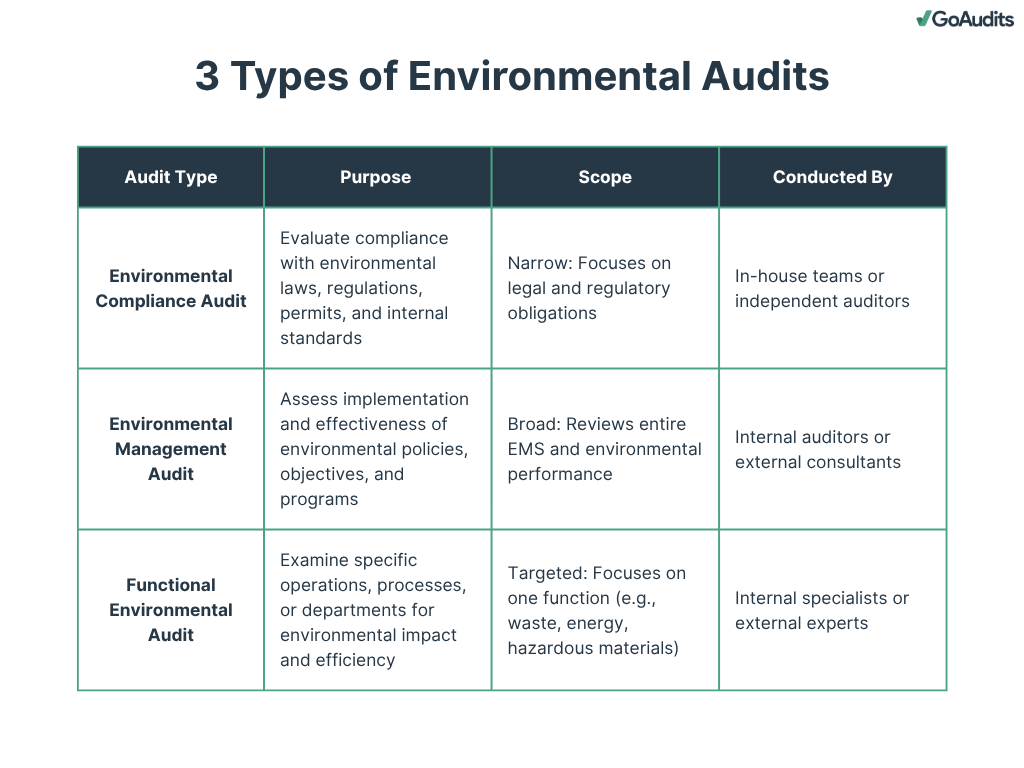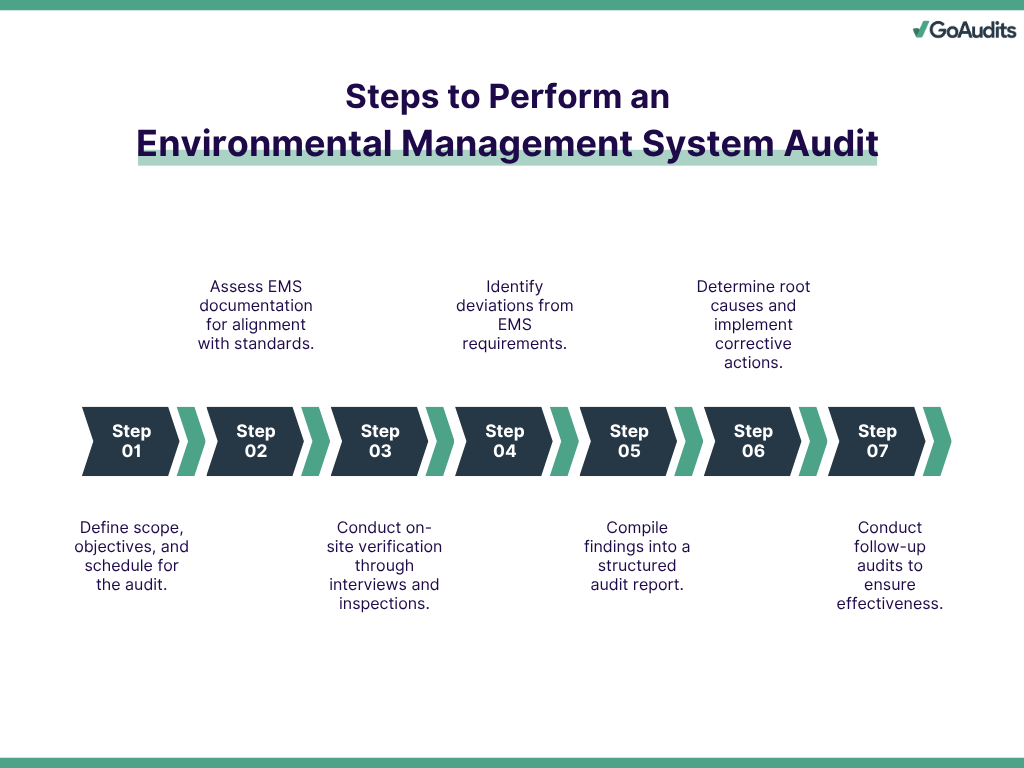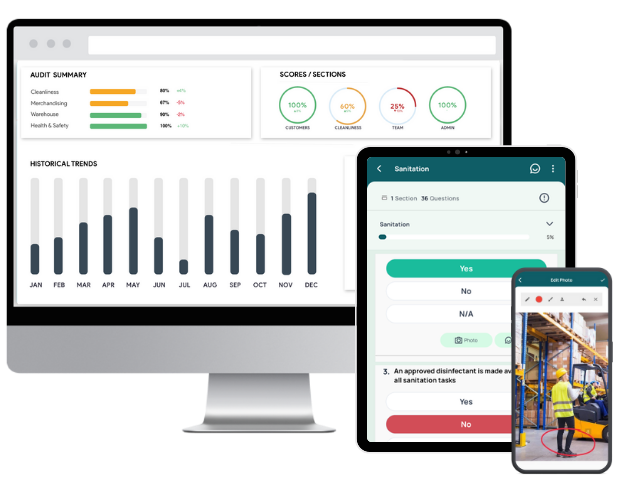An environmental management system (EMS) audit evaluates how well your organization manages its environmental responsibilities. When organizations align their EMS with ISO 14001, they can achieve 20% to 30% improvements in environmental performance, demonstrating twice the environmental and occupational health and safety performance compared to non-adopters. They also experience notable gains in operational efficiency, energy use optimization, waste management, and the effectiveness of incident response procedures. Globally, EMS adoption varies by region. The Asia-Pacific region leads adoption, with China and Japan accounting for nearly 60% of all ISO 14001 certificates. In Europe, countries like Italy, the UK, Spain, and Germany show strong and steady growth in certifications. In contrast, the United States trails behind in EMS adoption. Regular EMS audits are essential to enhance environmental performance, which leads to achieving and maintaining certification.
In this blog, we have discussed EMS audits in detail, covering the steps to perform them, types of environmental audits, and how EMS audit software can simplify auditing and reporting.
- What is an Environmental Management System Audit?
- What are the Three Types of Environmental Audits?
- What is the EMS Audit Process?
- Streamline EMS Internal Audits with EMS Audit Software
- What is EMS Audit Software?
- Factors to Consider When Choosing the Best EMS Audit Software
- How Can EMS Audit Software Help Generate EMS Audit Reports?
What is an Environmental Management System Audit?
An environmental management system (EMS) audit is a systematic, independent, and documented process to objectively evaluate whether your EMS complies with specified audit criteria, including ISO 14001 or other relevant standards. It determines if the EMS is effectively implemented and maintained, and whether it meets your organization’s environmental policy and objectives. The audit examines processes, procedures, records, and practices that influence environmental performance. It identifies non-conformities, risks, and areas for improvement.
EMS audits are essential for:
- Organizations seeking ISO 14001 certification or maintaining compliance
- Industries with significant environmental impacts (e.g., manufacturing, construction, energy, chemicals)
- Companies facing regulatory or stakeholder scrutiny
- Organizations with internal sustainability or ESG goals
Auditors can be internal or external (third-party auditors or certification bodies).
EMS audits must be performed:
- Regularly, as part of the EMS internal audit schedule (typically annually or semi-annually)
- Before certification or recertification audits
- After major changes in operations, processes, or legal requirements
- Following environmental incidents or non-compliance events
- During supplier evaluations, if environmental performance forms part of the procurement criteria
Why is EMS Audit Important?
Here’s why EMS audits are essential:
- An EMS audit helps you identify gaps in meeting environmental laws and regulations. It ensures that your processes, permits, and documentation align with legal requirements, minimizing the risk of non-compliance penalties and operational shutdowns.
- They assess how well your organization manages environmental aspects such as energy use, waste, emissions, and resource consumption. They enable you to reduce environmental impact, align with sustainability goals, and continuously improve your performance.
- Environmental risks can disrupt operations and damage brand reputation. EMS audits identify vulnerabilities and recommend preventive measures, helping you mitigate potential environmental liabilities before they escalate.
- Through the identification of wasteful practices and energy inefficiencies, EMS audits reveal opportunities to optimize resource use. This results in cost savings, particularly in energy, water, and waste management, without compromising compliance or quality.
- A well-executed EMS audit demonstrates transparency and accountability. It reinforces your commitment to environmental management, earning the trust of customers, regulators, investors, and the public.
- EMS audits are integral to achieving and maintaining ISO 14001 certification. They verify whether your system meets the standard’s requirements and support the implementation of best practices, ensuring readiness for external certification bodies.
- They create opportunities for employees to understand their environmental responsibilities. Engaging staff in audit processes increases awareness and drives organization-wide participation in sustainability efforts.
What are the Three Types of Environmental Audits?
Environmental audits can be classified into three distinct categories based on their scope and objectives:

1. Environmental Compliance Audit
It evaluates your organization’s adherence to environmental laws, regulations, permits, and internal standards. The focus lies on detecting non-compliance issues and implementing corrective actions to mitigate legal and financial risks.
Types of environmental compliance audits include:
- Internal EMS Audits: Conducted by in-house teams, they assess how effectively your EMS meets internal policies and regulatory requirements.
- External or Third-Party Audits: Performed by independent experts, these provide an unbiased evaluation of your compliance status. They are particularly valuable when preparing for regulatory inspections or seeking assurance for stakeholders.
- Certification Audits: These determine whether your EMS meets the standards of frameworks like ISO 14001. Leading to certification and enhancing credibility and stakeholder trust.
2. Environmental Management Audit
It reviews how well your environmental policies, procedures, and objectives are being implemented and maintained. Unlike compliance audits, the focus is broader. An environmental management audit evaluates overall environmental strategy, performance metrics, and the effectiveness of environmental programs.
Both internal and external audits fall under this category. Internal audits help you identify performance gaps and align operations with environmental goals. External audits provide an objective review and often deliver strategic insights for continuous improvement.
3. Functional Environmental Audit
Functional audits target specific operations, departments, or processes within your organization. These are detailed, focused assessments designed to uncover inefficiencies, risks, or impacts related to a particular function, such as waste management, energy use, or hazardous material handling.
Again, these can be both internal and external. Internal functional audits are conducted by specialized teams familiar with your systems. External functional audits are carried out by domain experts who bring industry benchmarks and technical objectivity.
What is the EMS Audit Process?
The EMS audit process follows a defined sequence of steps, listed below, to examine whether the EMS is effective, compliant, and aligned with environmental objectives.

Create an EMS Audit Plan
Begin by defining the audit scope, objectives, and criteria. Select qualified auditors and schedule audit dates. Prioritize areas with high environmental impact or past non-conformities. Planning also involves a risk-based approach to ensure critical areas receive adequate focus. A detailed audit plan is then shared with all stakeholders to align expectations.
Review Documents
Assess EMS documentation before the on-site audit. Review the environmental policy, legal registers, objectives, procedures, training records, and internal audits. Evaluate whether these documents align with ISO 14001 requirements. It ensures the system is properly designed and implemented on paper before checking its application.
Perform On-Site Audits
Conduct on-site verification through interviews, observation, and inspection, validating practical implementation. Confirm that EMS procedures are followed at all operational levels. Collect objective evidence to support audit findings. Evaluate employee awareness, operational control, emergency preparedness, and legal compliance.
👉 Free Resources
GoAudits offers a wide range of checklists to streamline every stage of the EMS audit process, perform structured on-site evaluations, verify regulatory compliance, and conduct ISO 14001 audits to ensure alignment with all standard clauses.
→ Environmental Audit Checklist Template
→ Environmental Inspection Checklist
→ ISO 14001 Self-Assessment Checklist
→ ISO 14001 Requirements Checklist
→ ISO 14001:2015 Readiness Assessment Checklist
→ ISO 14001 Internal Audit Checklist
→ ISO 14001 Gap Analysis Checklist
Identify Non-Conformities
Identify deviations from EMS requirements, whether internal procedures or ISO 14001 standards. Classify non-conformities as major or minor. Provide clear, factual evidence and link each issue to specific clauses. This ensures traceability and transparency, helping the organization understand exactly what needs correction.
During EMS audits, identified nonconformities are generally categorized as either major or minor, based on their impact on the EMS’s effectiveness. Common nonconformities identified during EMS audits include:
- Failure to document environmental procedures
- Missing or inadequate records
- Inaccurate or missing equipment calibration
- Ineffective evaluation of compliance
- Lack of management reviews or incomplete reviews
- Lack of a compliance register or a register not maintained
- Insufficient training or training records
- Environmental aspects and impacts are not fully recorded or evaluated
- Non-implementation of corrective or preventive actions
- Inconsistent practices and procedures
- Ineffective EMS audit program
Document Audit Findings and Report Them
Compile findings into a structured audit report. Include audit scope, objectives, methodology, observations, non-conformities, and positive practices. Ensure the report is objective, concise, and actionable. Submit the report to management for review and formal response. Proper documentation forms the basis for effective corrective action.
The key components of EMS audit reports include:
- Audit scope, objectives, criteria, and process description
- Methodology and evidence collected
- Findings summary, detailing satisfactory findings, non-conformance findings, and opportunities for improvement
- Nonconformance and corrective actions
- Conclusions and recommendations
- Executive summary
- Report distribution and follow-up plan
Implement Corrective Actions
For each non-conformance, the organization must determine root causes and implement corrective actions. Define responsibilities, deadlines, and methods for verification. Ensure actions address the underlying issues rather than symptoms. Effective corrective actions prevent recurrence and strengthen the EMS.
Follow-Up and Monitor
Conduct follow-up audits or reviews to verify that corrective actions were implemented and are effective. Monitor key environmental indicators to assess sustained compliance and performance. Continual monitoring ensures the EMS remains dynamic and responsive to changes in operations, regulations, and environmental impacts.
Streamline EMS Internal Audits with EMS Audit Software
Conducting effective internal audits is essential to ensuring your EMS complies with ISO 14001 and other standards. However, traditional auditing methods are slow, paper-heavy, and prone to errors. GoAudits transforms this process by streamlining every step into a single, intuitive mobile app.
You can conduct audits directly from a mobile device, even offline, and instantly generate audit reports enriched with data, photos, and corrective actions. As an all-in-one solution, GoAudits ensures transparency, accountability, and real-time insights, enabling you to maintain compliance, reduce risks, and improve operational efficiency without the administrative burden.

- Access pre-built EMS audit templates, easily customize them to match your specific environmental policies and procedures, or upload your existing forms and we’ll digitize them at no additional cost.
- Conduct audits from any device, anywhere, even without internet access. Capture e-signatures, photos, GPS data, and timestamps for full traceability.
- Automatically generate branded, professional reports after each audit. Include attached images, assigned corrective actions, scores, and detailed notes. Share reports with the relevant team members instantly via email.
- Assign corrective actions to relevant team members with deadlines and priorities during audits. Track task status in a centralized dashboard for full accountability.
- Set automated workflows for audit approvals, task assignments, and escalations. Ensure the right people are notified at the right time via instant notifications.
View performance trends, recurring issues, and compliance gaps through interactive dashboards. Use historical insights to drive continuous improvement in your EMS.
What is EMS Audit Software?
EMS audit software is designed to facilitate, automate, and enhance the process of auditing an EMS. These systems are used by organizations to ensure compliance with standards such as ISO 14001, evaluate environmental policies, assess operational risks, and improve overall environmental performance.
It can help you:
- Simplify and streamline the audit process
- Automate documentation and reporting
- Improve compliance and readiness
- Implement corrective actions
- Customize and scale
Factors to Consider When Choosing the Best EMS Audit Software
Here’s how to choose EMS audit software that suits your organization’s needs:
Your Business Requirements
Start by identifying your specific audit goals to choose a solution tailored to your needs. Define the scale of your operations, the frequency of audits, the regulatory standards you must meet, and the complexity of your reporting process. If your team operates across multiple sites or follows ISO 14001 standards, your software must support multi-location audits and compliance mapping.
Must-Have Features
Prioritize essential functionalities that actively enhance your environmental performance and directly impact efficiency:
- Customizable Checklists: Allow you to align audit criteria with internal policies or evolving regulations.
- Mobile Auditing: Enables auditors to perform on-site inspections using mobile devices, increasing convenience and speed.
- Instant Report Generation: Facilitates real-time access to findings, improving decision-making and response times.
- Corrective Actions and Task Automation: Streamlines issue resolution with auto-assigned responsibilities and deadlines.
- Data Analytics and Dashboards: Helps track trends, identify risks, and drive continuous improvement.
Intuitive and Offline Capabilities
Ease of use directly affects user adoption and audit quality. Opt for EMS audit software with an intuitive interface that requires minimal training. It should also support offline functionality, critical for remote sites with limited connectivity. Once reconnected, data should automatically sync without loss.
Affordability and Scalability
Affordability must be balanced with functionality, meeting your current needs while accommodating future growth. Evaluate pricing models: per user or flat-rate subscriptions. Choose software that scales with your organization without hidden fees for added features or users.
Customer Reviews
Reviews offer insights into real-world performance. Focus on feedback related to usability, support responsiveness, and feature effectiveness. Look beyond high ratings and identify patterns in common complaints or praised features to assess long-term reliability and user satisfaction.
Data Security
Ensure the EMS audit software complies with industry security standards like ISO 27001 or SOC 2 since environmental data can be sensitive. Features such as role-based access control, audit logs, and encrypted data storage are essential to protect your operational and compliance data.
Customer Support Quality
Efficient support reduces downtime and accelerates implementation. Look for vendors offering 24/7 support, live chat, training resources, and dedicated account managers. Strong support ensures smooth onboarding and minimizes disruptions during audits.
Free Trials and Demos
Before finalizing, request a live demo and explore a free trial to validate performance before committing financially. Evaluate the software in your actual audit environment. Test key features, check offline functionality, and involve end-users to gather feedback.
How Can EMS Audit Software Help Generate EMS Audit Reports?
EMS audit software streamlines report creation by automating every step. Instead of compiling information manually, you can rely on structured, real-time tools to generate accurate, actionable reports immediately after each audit.
Instant Report Generation
You no longer need to compile data back at the office. EMS audit software generates detailed reports instantly once the audit is complete. This reduces administrative workload and speeds up decision-making.
Automated Data Input
Manual data entry is prone to delays and errors. With EMS audit software, reports are auto-filled with real-time inputs, geotagged photos, corrective actions, timestamps, and auditor details, ensuring consistency and reliability.
Real-Time Report Distribution
Distribute audit reports to relevant stakeholders the moment they are generated. The software enables automated email delivery, keeping your team informed without delay or manual intervention.
Customizable Report Formats
Every organization has unique standards. EMS audit software lets you customize the layout, branding, and content of your reports. This ensures a professional appearance that aligns with your corporate identity and regulatory requirements.
Comprehensive Audit and Historical Data
Each report includes not just current findings but also historical context. This allows you to track trends, identify recurring issues, and assess long-term compliance with environmental standards.
Automated Smart Scoring
EMS audit software applies scoring logic to evaluate performance across different sections. You can instantly gauge compliance levels and highlight critical areas without manually calculating or interpreting results.




